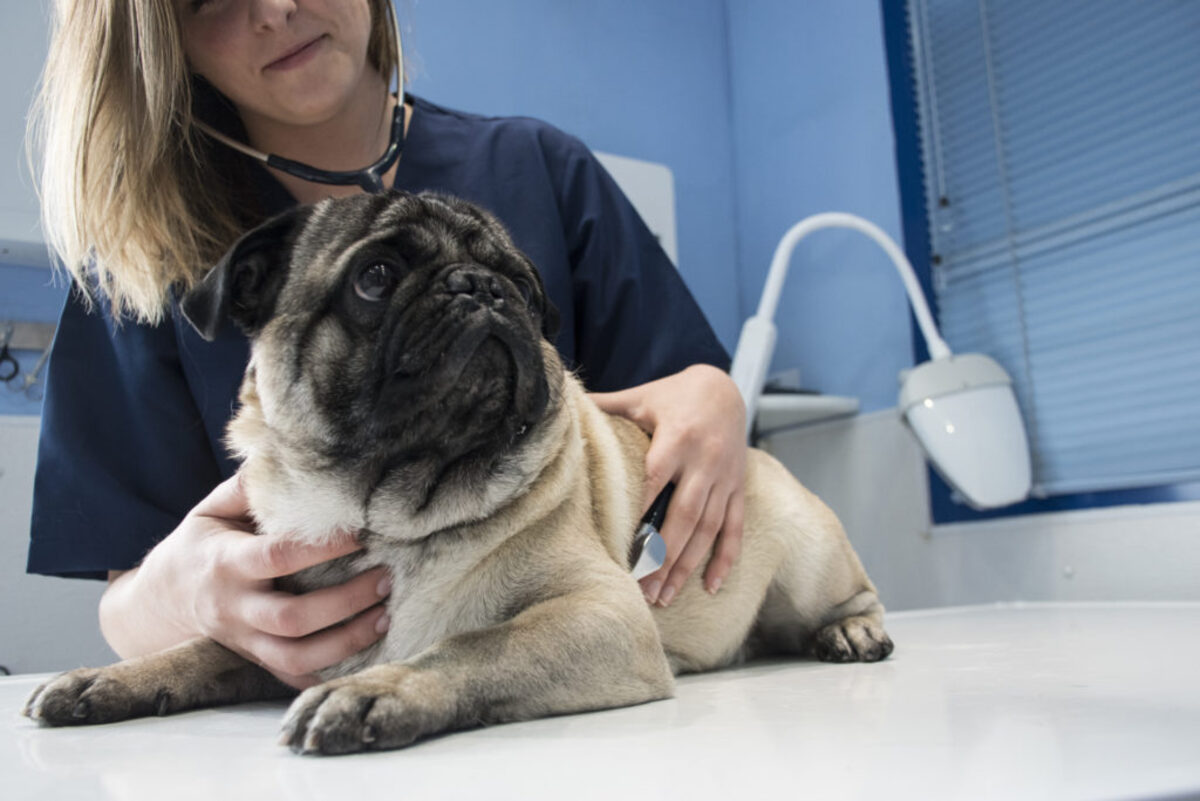Home>Health & Wellness>Common Health Issues>Is Cushing’s Disease Common In Diabetic Dogs And What Can We Do About It


Common Health Issues
Is Cushing’s Disease Common In Diabetic Dogs And What Can We Do About It
Published: January 30, 2024
Learn about the common health issue of Cushing's disease in diabetic dogs and discover effective management strategies. Understand the link between diabetes and Cushing's disease in dogs.
(Many of the links in this article redirect to a specific reviewed product. Your purchase of these products through affiliate links helps to generate commission for Pawsomeoldies.com, at no extra cost. Learn more)
Table of Contents
Introduction
Cushing's disease, also known as hyperadrenocorticism, is a common endocrine disorder that affects dogs, particularly those with diabetes. This condition occurs when the body produces an excessive amount of cortisol, a hormone that plays a crucial role in regulating metabolism, immune function, and stress response. When a diabetic dog develops Cushing's disease, it can exacerbate their existing health challenges, leading to a complex and potentially life-threatening situation.
Understanding the interplay between diabetes and Cushing's disease is essential for pet owners and veterinarians alike. The coexistence of these two conditions can significantly impact a dog's well-being, making it imperative to recognize the signs and seek appropriate care. By shedding light on the prevalence of Cushing's disease in diabetic dogs and exploring effective management strategies, we can empower pet owners to provide the best possible care for their furry companions.
In the following sections, we will delve into the intricacies of Cushing's disease in diabetic dogs, unraveling the common symptoms, diagnostic procedures, and treatment options available. Additionally, we will explore practical measures for managing Cushing's disease in diabetic dogs, offering insights into how pet owners can support their beloved pets through this challenging health journey. Let's embark on this enlightening exploration to gain a deeper understanding of Cushing's disease in diabetic dogs and discover the steps we can take to address this common health issue.
Understanding Cushing's Disease in Diabetic Dogs
Cushing's disease, or hyperadrenocorticism, is a condition characterized by the overproduction of cortisol, a hormone that regulates various bodily functions. When this disorder occurs in diabetic dogs, it can complicate their existing health challenges, posing significant concerns for pet owners and veterinarians. Understanding the intricate relationship between Cushing's disease and diabetes is crucial for effectively managing the well-being of affected dogs.
In diabetic dogs, the presence of Cushing's disease can exacerbate the symptoms of diabetes, leading to increased thirst, excessive urination, and fluctuations in blood sugar levels. The overproduction of cortisol can also weaken the immune system, making diabetic dogs more susceptible to infections and other complications associated with diabetes.
Furthermore, the symptoms of Cushing's disease, such as increased appetite, weight gain, and muscle weakness, can overlap with those of diabetes, making it challenging to discern the specific underlying issues affecting the dog's health. This overlap underscores the importance of thorough veterinary evaluation to accurately diagnose and address both conditions.
The coexistence of diabetes and Cushing's disease in dogs necessitates a comprehensive approach to management. Veterinarians play a pivotal role in conducting thorough examinations, including blood tests, urine analysis, and imaging studies, to assess the dog's overall health and identify the presence of Cushing's disease alongside diabetes.
By gaining a deeper understanding of the complexities associated with Cushing's disease in diabetic dogs, pet owners can become more attuned to their pets' health needs. This awareness enables them to collaborate closely with veterinarians to monitor their diabetic dogs for any signs of Cushing's disease, facilitating early detection and intervention.
In essence, comprehending the nuances of Cushing's disease in the context of diabetes empowers pet owners to advocate for the holistic well-being of their furry companions. Through education and proactive engagement with veterinary professionals, pet owners can navigate the challenges posed by the coexistence of these conditions, ultimately enhancing the quality of life for diabetic dogs affected by Cushing's disease.
Common Symptoms of Cushing's Disease in Diabetic Dogs
Identifying the common symptoms of Cushing's disease in diabetic dogs is crucial for timely intervention and effective management of this complex health issue. The coexistence of diabetes and Cushing's disease can manifest in a range of noticeable signs, signaling the need for comprehensive veterinary evaluation and targeted care.
-
Increased Thirst and Urination: Diabetic dogs with Cushing's disease may exhibit amplified thirst and urination, which can exacerbate the challenges associated with diabetes. The combination of these symptoms can lead to heightened fluid intake and frequent urination, impacting the dog's comfort and overall well-being.
-
Changes in Appetite and Weight: Dogs affected by Cushing's disease often experience increased appetite, leading to excessive eating and weight gain. This can be particularly concerning for diabetic dogs, as it can disrupt their dietary management and insulin requirements, potentially affecting their blood sugar levels and overall health.
-
Muscle Weakness and Lethargy: Cushing's disease can contribute to muscle weakness and lethargy in diabetic dogs, diminishing their energy levels and hindering their mobility. These symptoms can further complicate the management of diabetes, as physical activity and exercise play a vital role in regulating blood sugar levels and promoting overall health.
-
Skin and Coat Changes: Dogs with Cushing's disease may develop skin issues such as thinning, hair loss, and a predisposition to skin infections. These dermatological manifestations can exacerbate the challenges faced by diabetic dogs, necessitating diligent skin care and monitoring to prevent secondary complications.
-
Pot Belly and Enlarged Abdomen: The presence of a pot belly or visibly enlarged abdomen in diabetic dogs with Cushing's disease can indicate the accumulation of abdominal fat, a characteristic feature of this condition. This physical manifestation warrants attention, as it can impact the dog's comfort and mobility.
-
Increased Panting and Heat Intolerance: Cushing's disease can lead to increased panting and heat intolerance in diabetic dogs, affecting their thermoregulation and overall comfort. These symptoms may pose additional challenges, especially in warm climates or during physical exertion.
By recognizing these common symptoms of Cushing's disease in diabetic dogs, pet owners can proactively collaborate with veterinarians to monitor their pets' health and seek timely intervention when necessary. This heightened awareness empowers pet owners to advocate for the comprehensive well-being of their diabetic dogs, fostering a supportive environment for effective management and care.
Diagnosis and Treatment Options
Diagnosing Cushing's disease in diabetic dogs involves a multifaceted approach aimed at identifying the underlying hormonal imbalances and assessing the overall health of the affected animals. Veterinary professionals employ a combination of diagnostic tests and clinical evaluations to accurately diagnose Cushing's disease and devise tailored treatment plans. Additionally, the management of Cushing's disease in diabetic dogs encompasses a range of treatment options aimed at addressing the hormonal irregularities and mitigating the associated symptoms.
Diagnostic Procedures
Veterinarians rely on various diagnostic procedures to confirm the presence of Cushing's disease in diabetic dogs. These may include blood tests to assess cortisol levels, urine analysis to detect abnormal hormone excretion, and imaging studies such as ultrasound or radiography to evaluate the adrenal glands. Additionally, the low-dose dexamethasone suppression test and the adrenocorticotropic hormone (ACTH) stimulation test are commonly utilized to pinpoint the specific hormonal imbalances indicative of Cushing's disease. Through these comprehensive diagnostic measures, veterinarians can establish a definitive diagnosis and gain insights into the extent of the hormonal dysregulation in diabetic dogs affected by Cushing's disease.
Read more: What Can I Do For A Diabetic Dog
Treatment Options
Once a diagnosis is confirmed, the treatment of Cushing's disease in diabetic dogs focuses on addressing the underlying hormonal imbalances and managing the associated symptoms. Treatment options may include medication to regulate cortisol production, dietary modifications to support overall health, and close monitoring of blood sugar levels to ensure optimal diabetes management. Additionally, surgical intervention to remove adrenal tumors, if present, may be considered in certain cases. The selection of treatment modalities is tailored to the individual needs of the diabetic dog, taking into account their overall health status and the specific manifestations of Cushing's disease.
Ongoing Management and Monitoring
Following the initiation of treatment, ongoing management and monitoring are essential to track the dog's response to therapy and adjust treatment protocols as needed. Regular veterinary check-ups, including hormonal assessments and physical examinations, enable veterinarians to gauge the efficacy of treatment and make informed decisions regarding the dog's care. Moreover, diligent monitoring of diabetes management, including insulin administration and dietary control, remains integral to supporting the overall well-being of diabetic dogs with concurrent Cushing's disease.
In essence, the diagnosis and treatment of Cushing's disease in diabetic dogs require a comprehensive and tailored approach, encompassing thorough diagnostic evaluations, targeted treatment modalities, and vigilant ongoing management. By leveraging these strategies, veterinarians can optimize the care provided to diabetic dogs affected by Cushing's disease, ultimately enhancing their quality of life and fostering a supportive environment for their health and well-being.
Managing Cushing's Disease in Diabetic Dogs
Effectively managing Cushing's disease in diabetic dogs requires a holistic and proactive approach aimed at addressing the complex interplay between these two conditions. By implementing targeted strategies and fostering a supportive environment, pet owners and veterinary professionals can optimize the well-being of diabetic dogs affected by Cushing's disease.
Dietary Management and Exercise
Dietary modifications play a crucial role in managing Cushing's disease in diabetic dogs. A balanced and nutritious diet, tailored to the specific needs of diabetic dogs with concurrent Cushing's disease, can support overall health and help regulate weight. Pet owners should work closely with veterinarians to develop a dietary plan that aligns with the dog's nutritional requirements and complements their treatment regimen. Additionally, regular exercise, adapted to the dog's capabilities, can contribute to weight management and promote physical well-being, thereby enhancing the management of both diabetes and Cushing's disease.
Read more: What To Do About A Dog With Wheat Allergies?
Environmental Support and Comfort
Creating a supportive and comfortable environment for diabetic dogs with Cushing's disease is essential for their overall well-being. Providing ample opportunities for rest and relaxation, as well as minimizing stressors in the dog's surroundings, can help alleviate the impact of Cushing's disease on their daily life. Additionally, maintaining a consistent routine and ensuring a calm and nurturing atmosphere can contribute to the dog's comfort and emotional stability, fostering a positive environment for their health management.
Collaboration with Veterinary Professionals
Collaboration with veterinary professionals is paramount in the effective management of Cushing's disease in diabetic dogs. Pet owners should maintain open communication with their veterinarians, actively participating in the dog's care and seeking guidance on monitoring their health. Regular veterinary check-ups and ongoing assessments enable timely intervention and adjustments to the treatment plan, ensuring that the dog's unique needs are met and their health is optimized.
Supportive Care and Monitoring
Diligent monitoring of the dog's health, including regular assessments of blood sugar levels, hormonal balance, and overall well-being, is integral to managing Cushing's disease in diabetic dogs. Pet owners should remain vigilant in observing any changes in the dog's behavior, appetite, or physical condition, promptly reporting any concerns to their veterinarians. By providing attentive and supportive care, pet owners can contribute to the comprehensive management of both diabetes and Cushing's disease, promoting the dog's long-term health and quality of life.
In essence, managing Cushing's disease in diabetic dogs necessitates a multifaceted and compassionate approach, encompassing dietary management, environmental support, collaboration with veterinary professionals, and diligent monitoring. By embracing these strategies, pet owners can play a pivotal role in optimizing the well-being of their diabetic dogs affected by Cushing's disease, fostering a nurturing environment that supports their health and vitality.
Conclusion
In conclusion, the coexistence of Cushing's disease and diabetes in dogs presents a multifaceted health challenge that demands careful attention and proactive management. The intricate interplay between these two conditions underscores the importance of comprehensive veterinary care and ongoing support from pet owners. By recognizing the common symptoms, understanding the diagnostic procedures, and exploring the treatment options, we can navigate the complexities of Cushing's disease in diabetic dogs with greater insight and awareness.
The journey of managing Cushing's disease in diabetic dogs extends beyond medical interventions, encompassing dietary management, environmental support, and collaborative engagement with veterinary professionals. Through a holistic approach that addresses the physical, emotional, and environmental aspects of the dog's well-being, pet owners can create a nurturing and supportive environment that optimizes the management of both conditions.
Furthermore, the proactive involvement of pet owners in monitoring the dog's health, advocating for regular veterinary assessments, and providing attentive care is instrumental in promoting the long-term health and quality of life of diabetic dogs affected by Cushing's disease. By fostering a collaborative partnership with veterinary professionals and remaining attuned to the dog's unique needs, pet owners can navigate the complexities of managing these concurrent conditions with diligence and compassion.
Ultimately, the journey of addressing Cushing's disease in diabetic dogs is a testament to the unwavering bond between pets and their owners. Through education, proactive engagement, and a steadfast commitment to the well-being of their furry companions, pet owners can navigate the challenges posed by these conditions, fostering an environment that prioritizes the health, comfort, and vitality of diabetic dogs affected by Cushing's disease.
In essence, by embracing a multifaceted approach that integrates medical care, dietary management, environmental support, and collaborative engagement, pet owners can optimize the well-being of their diabetic dogs, providing them with the care, comfort, and support they need to thrive in the face of these complex health challenges.













